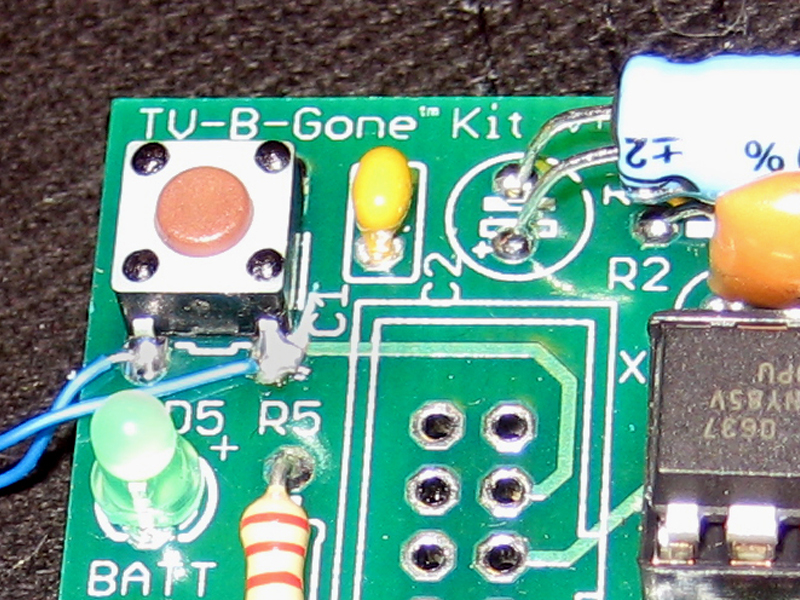“Hey, you mind turning that thing off?” Simple enough question, but I got tired of people looking at me like I’m from Mars. When a TV is on in the room, I can’t think. I just stare at the thing and drool.
So I invented TV-B-Gone, a key chain that stealthily turns off just about any television. When the TVs turn off, people turn on, engage in conversation, read, eat, and perform all sorts of human activities. Peace happens.
I recently teamed up with prolific kit maker Limor Fried to create a $20 kit version of the original TV-B-Gone key chain. This version works up to 40 yards away, and it’s totally hackable; the entire project is open source and documented at http://ladyada.net/make/tvbgone. Here’s how I built one into a baseball cap that lets me look at almost any TV, touch the top, and watch with glee as it shuts off.
Project Steps
How TV-B-Gone Works

TV remote controls all work the same way: by transmitting coded patterns of 940nm wavelength infrared to the television’s remote control receiver, somewhat like sending Morse code with a flashlight. The receiver watches for blinking IR, and when it sees patterns it recognizes, performs the corresponding functions on the TV. To avoid accidental triggering by reflected light in the room, receivers only respond to IR light that pulses at a specific carrier frequency.
For our TV-B-Gone, we don’t care about couch-surfing functionality; all we need is the code for turning a TV off. (Because remotes have just one on/off button, this is the same as the code to turn it on, and the TV’s current state determines which new state to toggle to.)
For example, to turn off a JVC TV, you blink the pattern shown in Figure A using a carrier frequency of 54kHz. The entire sequence lasts only a tiny fraction of a second, so there’s no perceivable delay.
Different manufacturers’ IR standards vary, but they all use rapid blinking of an even faster carrier frequency. TV-B-Gone transmits the on/off button codes for most TVs, one right after the other. So it works like other remotes, but with just one button.
Assemble the kit.
First I built the TV-B-Gone kit itself. I already knew how to do this, but you can follow the excellent instructions at ladyada.net/make/tvbgone.
Install the switch.

Take out the batteries and unsolder the battery leads from the board. Then bend the 4 legs of the tactile switch apart so they’re flat, and hot-glue the switch to the button on top of the cap.
Use needlenose pliers to push some of the wire-wrap wire through the hat fabric near the button. Pull enough wire through on the underside of the hat to reach the end of the visor.
Repeat using a second piece of wire, then solder the wires to 2 of the switch’s legs on the same side, clip off the other 2 legs, and cover the soldered joints with 1/16″ heat-shrink tubing.
If you use a lighter, be careful not to place the tubing (or the hat) directly in the flame. Hold the flame just above the tubing and move it around slowly until it’s fully shrunk.

Use a needle and thread to sew the 2 wires to the inside of the hat. I used 5 loops for each, tying them off with a square knot. Alternatively, you can also use hot glue.

Position the assembled TV-B-Gone at the edge of the visor of the hat, with the IR emitters just inside the brim, pointing outward. Cut the wires from the hat-top switch so they extend just past the switch button on the circuit board.
Install the battery pack.
Center the battery pack under the cap’s dome with its 2 wires facing forward, toward the visor. Hot-glue the battery pack in place, then sew (or hot-glue) its wires to follow the same paths as the switch wires.
Install the TV-B-Gone.

Trim and solder the wires to the battery terminals on the circuit board (BATT), red to + and black to -, covering the connections with 1/16″ heat-shrink tubing.
Trim and solder the 2 wires from the tactile switch and solder them to the 2 connected terminals for the onboard switch (S1). It does not matter which wire goes to which terminal.
Test.
Insert 2 batteries into the holder. The visible LED (LED5) should start blinking. If not, immediately take the batteries out and check that the battery leads aren’t reversed.
You can also confirm that all 4 of the TV-B-Gone’s IR emitters are blinking by watching them through a digital camera (most cameras can see IR).
After the TV-B-Gone turns itself off, pushing the button on top of the hat should restart the transmission sequence. If not, double-check the wires running from the hat switch to the board.
Final assembly.

Remove the batteries, then cover the circuit board with a 2″-long piece of 1″ heat-shrink tubing and shrink it in place.
After shrinking, cut little pieces out of the tubing to expose the visible light and the onboard switch.
Hot-glue the covered board to the underside of the visor with the IR emitters facing forward, as before. Finally, use a colored marker or paint to conceal the silver parts of the hat switch.
A Real-Life TV Story
We walk into a restaurant. Nice place — except there are 3 huge-screen TVs blaring from different corners. No one is watching any of them, so off they go. None of the customers even seem to notice, yet the waiter feels obliged to turn them back on.
No problem — off they go again. The waiter calls the manager, who grabs the remote control and turns them on again. Triumphant, they start to walk away. Off go the TVs once more. While they’re standing there, dumbfounded, I switch them all on. Then off. Their shoulders slump in unison, admitting defeat. We enjoy our meal and conversation.
I love my TV-B-Gone hat.
Conclusion
This project first appeared in MAKE Volume 13.
Related Posts on Make: Online:
TV-B-Gone Hoodie
blog.makezine.com/archive/2008/09/tvbgone_hoodie.html
Double the Range of Your TV-Be-Gone
http://blog.makezine.com/archive/2007/04...
Ultra TV-B-Gone






